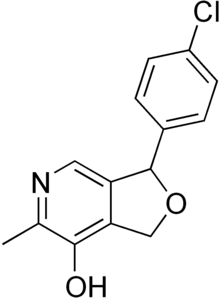Cicletanine is a furopyridine compound usually used in the treatment of hypertension.[1] The drug is most-commonly known as a diuretic drug, but has a broader range of cardiovascular and metabolic activity characterized extensively in the literature (see "Mechanism" below).
 | |
| Clinical data | |
|---|---|
| AHFS/Drugs.com | International Drug Names |
| Routes of administration | Oral |
| ATC code | |
| Pharmacokinetic data | |
| Protein binding | 97.3% |
| Elimination half-life | 7.9 h |
| Identifiers | |
| |
| CAS Number | |
| PubChem CID | |
| ChemSpider |
|
| UNII | |
| KEGG |
|
| ChEMBL | |
| CompTox Dashboard (EPA) | |
| ECHA InfoCard | 100.158.583 |
| Chemical and physical data | |
| Formula | C14H12ClNO2 |
| Molar mass | 261.71 g·mol−1 |
| 3D model (JSmol) | |
| |
| |
| (verify) | |
Cicletanine was originated and at first marketed by Paris-based Ipsen, who later licensed marketing rights in France to Milan-based Recordati. Ipsen and Recordati both marketed cicletanine under the trade name Tenstaten. The drug is no longer manufactured nor sold by IPSEN; it is currently marketed in France by three generics manufacturers: Viatris, Biogaran, and Teva.
Cicletanine has been shown to be differentially potent in salt-sensitive hypertension.[2]
Cicletanine is officially in the category of “Diurétiques thiazidiques et apparentés” (“thiazide and related diuretics”). Its mechanism of action in hypertension, however, involves decreases in blood pressure (due to vasorelaxant activity) at 50 and 100 mg, doses below the 150 mg that is usually the lowest dose associated with diuretic activity. In fact, a significant majority of cicletanine patients take daily doses of 50 or 100 mg.
While a comprehensive survey of cicletanine's mechanism of action has yet to be published, it is now known that the drug's vasorelaxant activity is due in part to activation of eNOS (endothelial nitric oxide synthase), an enzyme central to endothelial function.
It can inhibit protein kinase C.[3]
This drug article relating to the cardiovascular system is a stub. You can help Wikipedia by expanding it. |